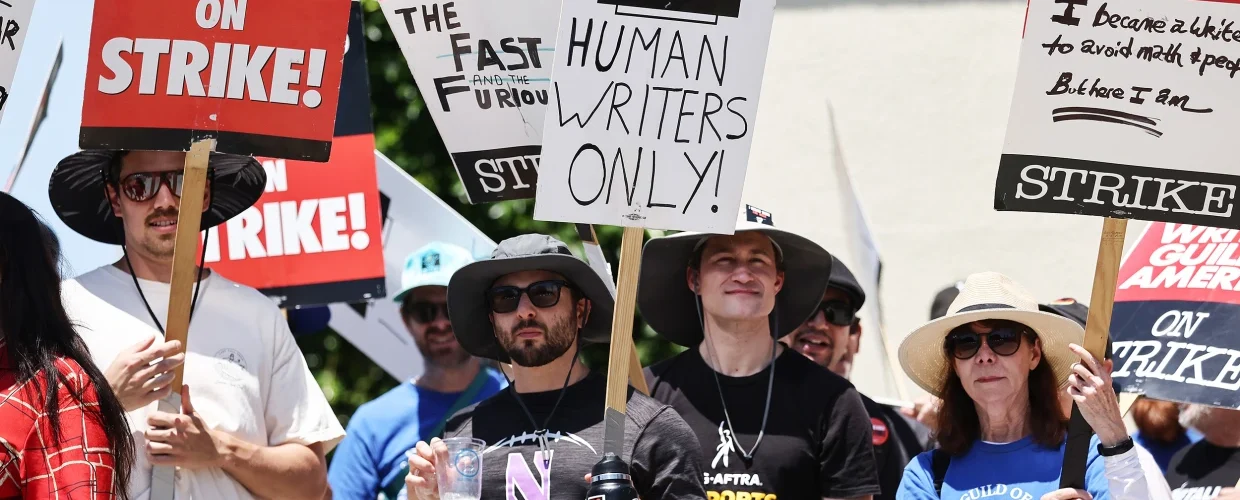Employees have managed to claim a seat in the AI conversation this year. Will it prove to be satisfactory?

“From Hollywood to Microsoft, labor groups are extending their influence over the utilization of artificial intelligence in the workplace, yet concerns persist that technology may outpace their efforts.”
In 2023, workers asserted their demand for increased influence in shaping how artificial intelligence transforms their industries, achieving remarkable successes from Hollywood to Silicon Valley. However, as technology advances rapidly and regulators strive to keep pace, labor experts question the potential effectiveness of this advocacy.
Earlier this month, Microsoft and the AFL-CIO, a coalition encompassing dozens of unions representing 12.5 million individuals, unveiled a partnership with the aim “to expand workers’ role in the creation of worker-centered design, workforce training, and trustworthy AI practices,” as highlighted by AFL-CIO President Liz Shuler in a news release.
While the agreement lacks specific details, it includes “learning sessions” involving labor leaders and workers, facilitated by Microsoft’s AI experts. Additionally, the partnership outlines intentions to propose new policies to Congress regarding AI upskilling, aiming to create and preserve jobs for humans in the face of expanding technology.
This collaboration marks a significant step towards empowering workers in the AI landscape, yet the ultimate effectiveness of this push remains uncertain, given the evolving nature of technology and regulatory challenges.
The acknowledgment by one of the world’s major companies that joining a union should be solely the workers’ choice sends an important signal, according to Harris. This is especially significant in an environment where many employers strongly oppose worker organizing efforts. The AFL-CIO declined to comment, and Microsoft, while pointing to its public statements and labor policies, refrained from providing additional comments. This partnership announcement followed recent leadership changes at OpenAI, the creator of ChatGPT, where major investor Microsoft played a role in reversing the startup’s decision to fire CEO Sam Altman. This intervention led to Microsoft securing a nonvoting role on OpenAI’s board, positioning the company favorably in steering AI development in alignment with its business goals. Labor experts cautioned that this strong position might limit the impact of workers’ newfound influence. Kate Bronfenbrenner, director of labor education research at Cornell University, acknowledged the AFL-CIO alliance as a positive development but raised questions about the extent of workers’ influence over AI. She pondered scenarios where workers express concerns, asking, “What if the workers get involved and they say, ‘You know what, it’s too much of a problem’? Of course, the company’s not going to stop doing it.” Bronfenbrenner suggested that Microsoft might be pursuing positive publicity following scrutiny of its Activision takeover. Beyond the tech sector, workers are actively safeguarding their jobs from AI-fueled automation. In recent months, screenwriters and actors have ratified new contracts that restrict film and TV studios’ use of AI for generating scripts or virtual performers, with specific provisions on compensating writers and actors in such instances.

Those concessions were partly a case of lucky timing, with three major Hollywood unions’ contracts all up for renegotiation just as interest in generative AI exploded across industries. While labor leaders touted their wins as groundbreaking and the contracts were approved by wide margins, the AI provisions didn’t escape criticism. Some actors had wanted stronger curbs on the use of their likenesses to train AI models. Alex Plank, a SAG-AFTRA member, told NBC News earlier this month that he was disappointed that studios looking to use virtual actors “just have to notify SAG and bargain with the union” over doing so, which he called tantamount to “allowing synthetic performers to compete with human ones.” In a forthcoming Nielsen survey of 3,000 U.S. workers conducted this fall and viewed by NBC News, many reported feeling conflicted about AI’s future impact on their livelihoods. While about 36% of those surveyed said tools like ChatGPT would make their jobs easier, more than half were concerned AI would reduce their professional opportunities. Charlene Polite Corley, vice president of diverse insights and partnerships at Nielsen, said the initiative between Microsoft and the AFL-CIO could ease some of those worries. “One key benefit of this partnership could be inclusion of more socioeconomic diversity throughout the development of AI solutions and policies,” she said. “With the rate of adoption of this technology just in the last year, there hasn’t always been that pause to evaluate how AI may increase inequity.”
The White House has sought to boost labor in a year of historic worker organizing, with Biden joining a United Auto Workers picket and championing new rulings by the National Labor Relations Board making it easier for more employees to unionize.
“The Biden-Harris administration firmly believes that workers need a seat at the table in the development and use of AI,” said Muneer Ahmad, senior counsel to the secretary at the Department of Labor. He hailed the pact at Microsoft as a potential “model for other labor-management partnerships.”
In the meantime, Bronfenbrenner said labor advocates have their work cut out in navigating the proliferation of AI tools in the workplace, particularly those for tracking and improving productivity. Some “tattleware” that expanded rapidly during pandemic-era remote work can take screenshots of company-issued devices without alerting employees, as well as log their keystrokes or website visits.
“And that’s just the surveillance that we’re aware of,” she said. “We need to learn a lot about how it’s affecting workers in industries from media to technology to education. Are there ways it can be helpful, or is the primary purpose of it going to be to just cut costs and replace workers?”
Source : NBC News








